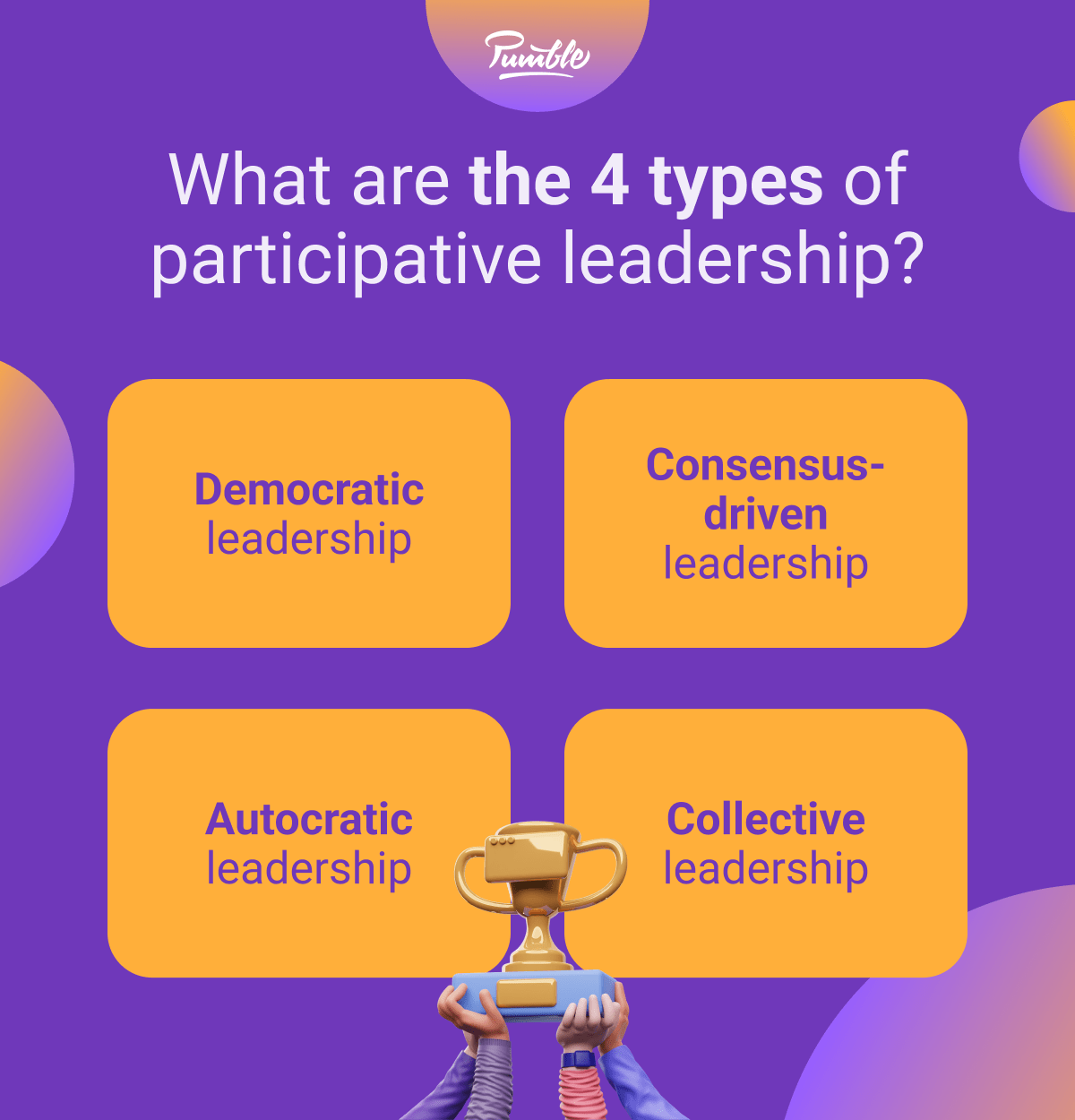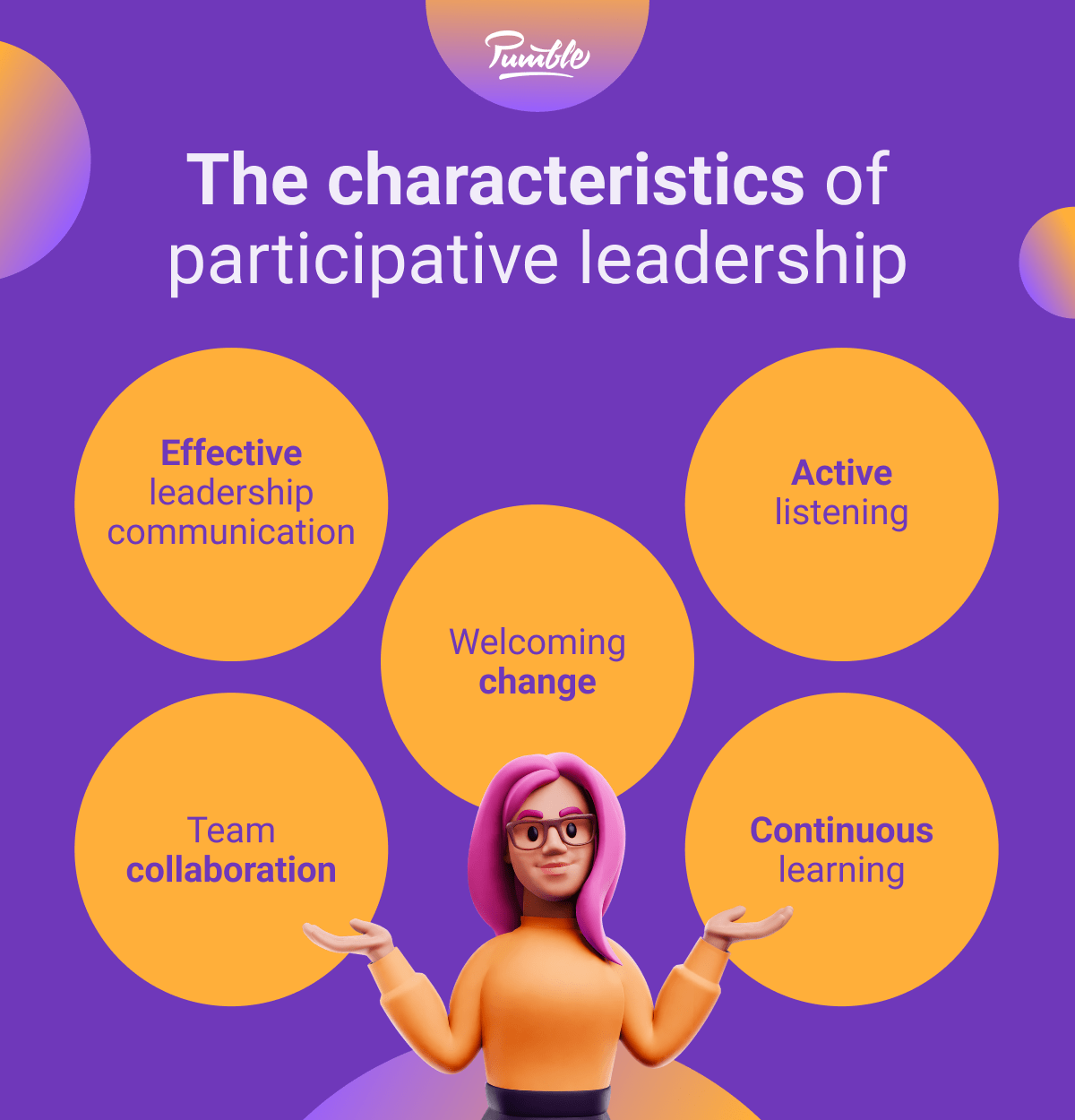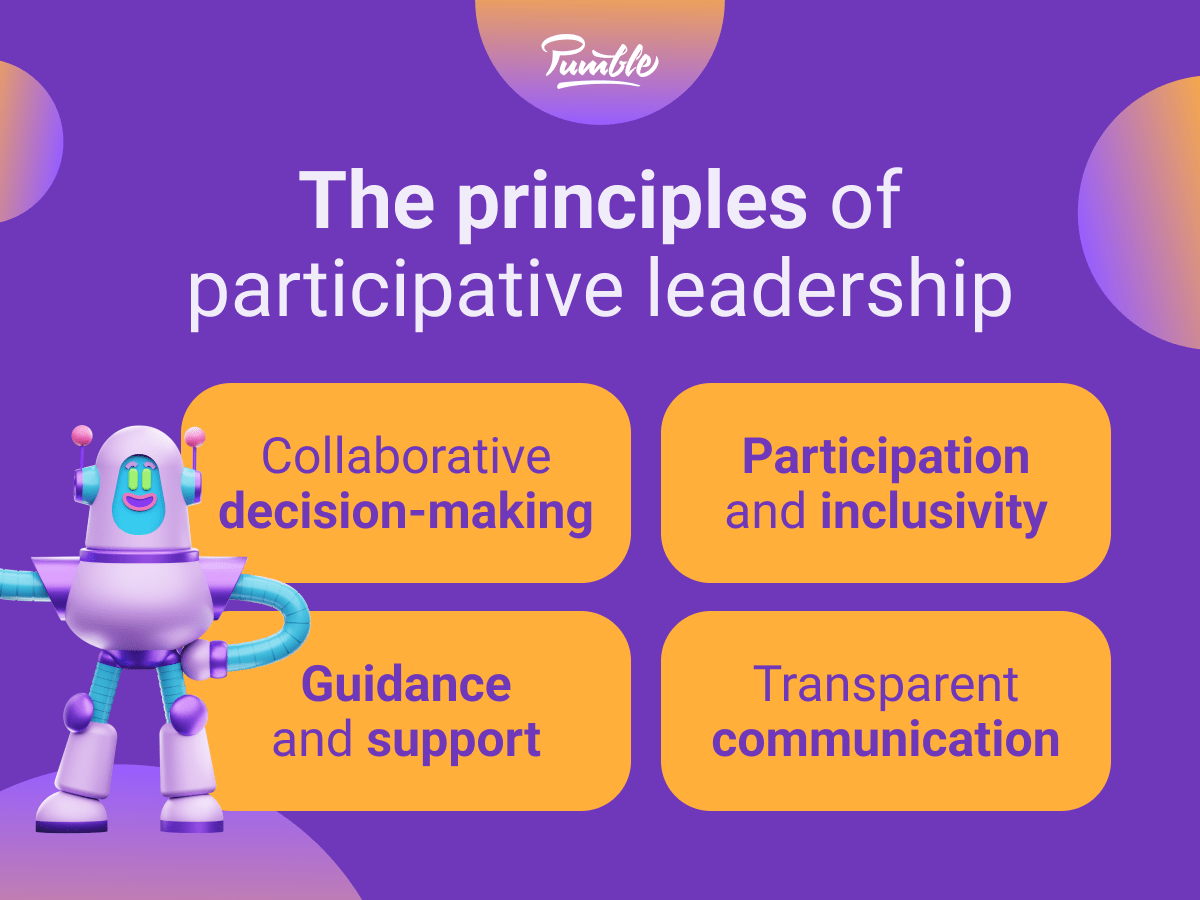The journey to becoming a leader is fraught with many trials and tribulations. Not only does the process involve continuous learning and self-development, but people are afraid of alienating others by being too blunt or demanding.
After all, traditional associations with the word “boss” point to a pushy individual with a domineering manner.
But, are there leaders who avoid the pitfalls of traditional leadership by choosing a more team-centered approach?
Fortunately, the rise of participative leaders in different organizations has shown that there are several ways to nurture employee engagement and a nontoxic work culture.
In this blog post, we will dive deeper into the nooks and crannies of the participative leadership theory and examine:
- The definition of participative leadership,
- The 4 types of this approach,
- The principles and characteristics typical of participative leaders, and
- Tips on how to become an effective participative leader.
However, before focusing on any specifics, we have to define participative leadership and clear up potential uncertainties.

Table of Contents
What is participative leadership?
At the core of the participative leadership style lie democracy and teamwork. Doing away with the top-down approach, participative leadership encourages everyone to work together to resolve pressing issues and make decisions.
Thus, managers encourage participation from all members, sometimes even addressing challenges by implementing a voting system. As a result, the organization enjoys a democratic atmosphere, which strengthens morale and ensures everyone knows about company goals. For this reason, participative leadership is also referred to as democratic leadership.
💡 Pumble Pro Tip
There can be no participative leadership without teamwork and collaboration. But, what are the differences between the two? And, how can you promote them within your team or department? To learn more, see this guide:
What are the 4 types of participative leadership?
Edwin A. Locke, a professor of motivation and leadership at the University of Maryland, writes that the participative leadership style is primarily a “managerial technique.”
In the article Participation in Decision-Making: One More Look, Locke and his collaborator explain that participation aids in distributing power among hierarchically unequal people.
However, the success of power-sharing hinges on the extent of participation managers elicit or want from their team.

Depending on how much team collaboration is involved, we can recognize 4 leadership styles within the participative leadership theory. These are:
- Democratic leadership,
- Consensus-driven leadership,
- Autocratic leadership, and
- Collective leadership.
So, what are they all about?
Type #1: Democratic leadership
The key element of democratic leadership is inviting others to provide feedback on particular issues or challenges.
Of course, it is the responsibility of the organization’s leadership to rule on the final decision. However, managers will hear out their teams to ensure they can alleviate their stress and address their concerns.
This practice guarantees employee visibility by bolstering the confidence of staff members and increasing cohesion within departments.
Type #2: Consensus-driven leadership
This type of leadership provides the highest level of participation.
Typically, managers use a voting system encouraging teams to reach unanimous decisions with company-wide consequences.
Although managers can give specific information to streamline the process, they don’t interfere while the group is deliberating. Hence, they hold off initiating any action until everyone is on the same page.
Type #3: Autocratic leadership
Autocratic leadership ranks the lowest in participation, but that doesn’t mean it completely discounts employee input.
Employees are welcome to voice their opinions and may sometimes even be prompted to elaborate on their concerns.
Yet, the final decision is up to management, which isn’t obligated to justify its actions to staff.
Type #4: Collective leadership
While the degree of participation in collective leadership is slightly lower than that of consensus-driven leadership, it still relies on group decision-making.
By urging people to work together and collaborate on many projects, managers make sure everyone is accountable for their part of the job. This prevents the formation of team silos and promotes accountability, which can be an area remote workers struggle with.
💡 Pumble Pro Tip
For ideas on how to foster teamwork and collaboration in a professional environment, check out this extensive guide:
Empower your team to work together better in Pumble
The characteristics of participative leadership
While different people may prefer different types of participative leadership, several characteristics are typical of most versions of this leadership strategy.

Characteristic #1: Effective leadership communication
Regardless of which leadership model you follow, it will most likely backfire without effective leadership communication.
The participative leaders communicate messages to immediate team members and those from other departments sets an example for everyone and can lead to the formation of negative and positive attitudes.
Characteristic #2: Active listening
Active listening is much more than simply giving someone the time of day.
It encompasses a range of techniques that allow us to hear what our interlocutor is saying and accurately interpret the message underneath their words. Thus, we pay attention not only to what they are saying but also to context and body language.
Through this conscious effort, participative leaders gain a deeper understanding of what they hear and the insight to respond in an appropriate and supportive manner.
💡 Pumble Pro Tip
For more information on how to make active listening work in your personal and professional life, see this guide:
Characteristic #3: Welcoming change
Democratic leaders take pride in their flexibility and welcome change as an opportunity for growth and professional development.
They recognize that testing novel techniques and ideas may pave the way to sustainable success. Consequently, they are ready to think outside the box and inspire others to follow in their footsteps.
Characteristic #4: Team collaboration
Unfortunately, obstacles to successful collaboration abound in the business world, and it’s up to leaders to help their teams overcome problems.
However, good leaders know they cannot do this alone.
Knowing that everyone brings a unique perspective to the table, democratic leaders tap into various insights to achieve a synergy that’s absent when you work on a problem independently.
Thus, managers will try different collaboration practices to increase productivity and allow the team to contribute their best work.
Characteristic #5: Encouraging continuous learning
Democratic leaders understand how important it is to keep sharpening your skills.
They may work with the HR team to organize workshops on topics such as assertive communication or mental health in the workplace. What employees learn during these sessions can help them work out issues in both their personal and professional lives.
The principles of participative leadership
Leaders may adopt the participative leadership style to suit their specific goals. However, in nearly all versions of this leadership strategy, there are several principles that help guide leaders in the right direction.

In the following sections, we’ll devote more attention to learning about the principles of participative leadership.
Principle #1: Collaborative decision-making
Some people are wary of group decision-making because they fear the group will fall victim to groupthink.
But, it’s undeniable that approaching an issue as a team can be beneficial.
We spoke with Pelin Kohn, the Director of the Center for Leadership at Norwich University. She also acknowledged that this strategy could be the best option for certain groups. Kohn shared:

“The participative leadership model is ideal for team settings with members who are keen on taking initiative.”
The members should come from diverse backgrounds, and their different experiences will give rise to unique perspectives.
The leader may choose to be a devil’s advocate to push the group to tap into their critical thinking skills.
Once the group has agreed on the final decision, they share responsibility for the potential outcome.
Principle #2: Participation and inclusivity
According to a diversity report from McKinsey, companies prioritizing inclusion in the workplace significantly outperform their competitors.
Unfortunately, when people feel isolated due to remote-first policies or workplace microaggressions, their commitment and participation wane.
Democratic leaders aim to develop a long-term perspective that will lead to lasting positive change. For example, they may refine the organization’s diversity policies and implement company-wide education programs.
💡 Pumble Pro Tip
To learn how diversity, equity, and inclusion impact workplace communication, read this blog post:
Principle #3: Guidance and support
The difference between good leaders and great leaders is that the latter never stop investing in themselves. Therefore, exceptional leaders understand how beneficial it is to invest in their staff through guidance and support.
Promotion opportunities and benefits are a good foundation, but employees also appreciate opportunities to learn and further develop their skills. Depending on the organization’s current circumstances, frequent training and mentorship programs may not be a viable option.
The good news is managers can still impart knowledge to their teams. That may occur during weekly meetings or daily check-ins with team members.
These simple practices demonstrate to staff members that there is always someone who is happy to hear their questions and provide them with advice and thoughtful responses.
Principle #4: Transparent communication
In a workplace where one of the guiding principles is transparent communication, leaders ensure that all employees are privy to relevant information.
When democratic leaders establish an uninterrupted stream of information, they significantly improve lateral communication within teams. Moreover, by fostering a culture of openness, leaders make sure that staff have greater trust within the organization.
💡 Pumble Pro Tip
If you’re interested in learning more about transparent communication and how it may benefit your organization, consider reading this blog post:
Foster a culture of openness in Pumble
Examples of participative leadership
Many successful people have used the participative leadership style and leveraged its principles to their advantage.
By looking at the participative leadership examples below, we’ll try to see how these leaders have crafted their success stories.
Example #1: Muhtar Kent, former CEO and Chairman of the Board of Coca-Cola
“You can’t have a growing and thriving business unless your communities are also strong and thriving.”
Kent joined Coca-Cola in the late 1970s and stayed with the company until 2017. That same year, he took part in the Leadership Speakers Series at the University of Virginia, where he shared the pillars of his business outlook:
- Get to know the company’s inner workings and what makes it stand out.
- Don’t be afraid to make mistakes or take risks, and love what you do.
- Take any chance you can get to connect with the people around you.
- Cultivate diversity in teams.
Example #2: Indra Nooyi, former CEO and Chairman of the Board of PepsiCO
“Leadership is hard to define, and good leadership is even harder. But, if you can get people to follow you to the ends of the earth, you are a great leader.”
During her 12-year tenure as CEO, Nooyi became a formidable leader who believed in empowering others as she advanced her career. She called her philosophy the 5 C’s of leadership, which are:
- Competency: According to Nooyi, leaders should be experts in their field. However, they shouldn’t fall into a false sense of security. To stay relevant in the industry, they must seek out further learning opportunities.
- Courage and confidence: Leadership falls short without confidence and courage. Making tough decisions and having difficult conversations is part and parcel of leading a group of talented people toward success.
- Communication: Nooyi stresses that leaders should communicate transparently and stay receptive to feedback. Additionally, she underscores the importance of deep listening and tweaking your communication style to appeal to your audience.
- Consistency: A true leader should stay consistent in communication, decisions, and actions. To further build trust with their teams, leaders ought to establish clear goals and promote accountability in the workplace.
- Compass: For Nooyi, leaders should act according to their principles and values and never lose sight of them.
Example #3: Ginni Rometty, former Executive Chairman of IBM
“One of the most important things for any leader is to never let anyone else define who you are. And you define who you are. I never think of myself as being a woman CEO of this company. I think of myself as a steward of a great institution.”
After stepping down as chairman of the global tech powerhouse IBM, Rometty published her book, aptly called Good Power: Leading Positive Change in Our Lives, Work, and World.
In the book, she touches on:
- Her proven techniques for handling conflicts,
- Following your ambitions, and
- Welcoming discomfort in your professional life.
A big part of her leadership philosophy is that while your goals matter, how you achieve them may matter even more. Ultimately, for Rometty, diving into any venture requires skills, but your curiosity and gratitude are just as important.
Example #4: Tommy Lasorda, professional baseball player and manager
“I believe managing is like holding a dove in your hand. If you hold it too tightly, you kill it, but if you hold it too loosely, you lose it.”
The renowned baseball manager who propelled the Dodgers to success in the late 1980s and led the USA national team to Olympic gold in 2000 based his participative leadership style on the needs of his players.
For Lasorda, players weren’t there solely to win championships. He wanted to see how much the players could improve from one game to the next, and the results would come later.
Today, baseball enthusiasts remember Lasorda for his numerous accolades and nuanced, human-centered managing approach.
Why is participative leadership important?
Although there are many ways to optimize organizational management, participative leadership works best for creating a collaborative work culture.
In addition to improving employee satisfaction, it gives people a sense of security and stability. As team members collaborate with each other and their managers, they feel more comfortable experimenting and trying new solutions.
While more extensive research is yet to come regarding the effectiveness of participative leadership, academics have discussed the topic in recent years.
For example, in Participative Leadership: A Literature Review and Prospects for Future Research, the authors argue this management strategy carries more benefits for employees. Namely, it’s effective in:
- Creating a psychologically safe environment,
- Promoting employee well-being, and
- Building trust between management and staff.
However, Kohn highlights that it’s unwise to assume participative leadership will bring imminent success. She underscores that:

“It is important to remember that participative leadership depends on several factors, including:
- The context,
- The characteristics of the team or organization, and
- The leader’s ability to balance participation with timely decision-making.”
💡 Pumble Pro Tip
Regardless of which leadership strategy is the best fit, cultivating psychological safety should be at the top of your priorities. To learn how you can build psychological safety in your organization, check out this blog post:
Benefits of participative leadership
We’ve already mentioned the positive impact of the participative leadership model on organizations. Now, we’ll dive deeper into the theory’s specific benefits.
Benefit #1: Participative leadership boosts morale
The participative leadership style is gaining more traction because it’s founded on democratic principles.
The leader remains at the top of the hierarchy but doesn’t shun team members from the decision-making process. Not only does this provide visibility to individual team members, but it also enhances group morale.
And, there’s a strong case for building employee morale in the workplace. Namely, good morale aids people in tapping into valuable reserves of motivation. In turn, this helps organizations:
- Combat absenteeism,
- Decrease staff turnover,
- Build a solid reputation, and
- Increase employee productivity.
💡 Pumble Pro Tip
Boosting employee morale is no easy feat. If you would like to read some expert advice on how to support your staff, see this blog post:
Benefit #2: Participative leadership establishes unity
No matter how talented team members are, the business may waste their talent unless the group is united.
In a post about connectivity at work, McKinsey shared that 46% of employees believe being unable to work with people they know and trust is a valid reason to resign.
While it is unlikely democratic leaders will know everyone in their organization on a deep, personal level, they can still foster an environment of “belonging.” Some strategies they may implement include:
- Prioritizing and understanding human connection: Benefit packages may initially attract employees, but genuine connection with peers is what keeps them with the company. Leaders can suggest organizing knowledge-sharing sessions or holding in-person or online team-building activities to bring people together.
- Refining onboarding procedures: Personalizing onboarding to address new hires’ specific concerns and needs may help strengthen staff commitment.
- Empowering managers: Managers are often in a tough spot, trapped between higher-ups and their team members. Ensuring managers have the necessary resources to connect with the staff and leadership could help them excel.
- Promoting cross-functional communication: Initiatives like mentoring programs may allow different employees to connect and share knowledge. Furthermore, they promote cross-functional communication by preventing the formation of team silos.
💡 Pumble Pro Tip
Are you wondering how to help your remote team feel more connected? If so, look no further than this blog post:
Benefit #3: Participative leadership increases retention
The speed at which employees leave their jobs is increasing, and finding top talent to fill these positions is becoming more difficult.
But, leaders have the most impact on the trajectory of this employee journey. One of the simplest ways participative leaders can influence staff is by showing they care.
Through more personal conversations, vulnerability, and involving employees, leaders demonstrate that work doesn’t just revolve around getting the job done.
When people feel they are more than mere numbers, they are more likely to stay with their employer longer.
Benefit #4: Participative leadership encourages creative thinking
In business, structure and routine can guide you in the right direction. But, they don’t amount to much without creative thinking.
Bringing to life useful and innovative ideas relies on creativity. Because participative leaders work closely with their teams, they can easily avoid long periods of creative slumps.
Moreover, in environments where feedback and creative thinking matter, people find it easier to adapt to unexpected challenges.
Benefit #5: Participative leadership improves engagement
According to Gallup’s State of the Global Workplace 2023 Report, a mere 23% of employees are engaged at their workplace. Thus, a little over a fifth of the workforce thrives at work.
So, what is the secret ingredient that helps boost engagement?
For many organizations, it comes down to leadership.
In general, proponents of the participative style of leadership agree that team effort is invaluable.
After all, if your manager doesn’t show interest in what you have to offer, why bother putting your best foot forward?
But, because democratic leaders engage in deep listening to understand all sides of an issue, they know to give credit where credit is due.
Thanks to employee recognition, teams see how seriously leadership takes their contributions. Hence, they are motivated to be their best selves at their job.
💡 Pumble Pro Tip
For more concrete numbers on where employee engagement stands in 2023, check out this exhaustive guide:
Foster employee engagement in Pumble
Weaknesses of participative leadership
While the participative leadership theory can potentially yield great results, it’s far from a one-size-fits-all solution. And, if it doesn’t match your business goals, it can lead to significant issues.
For this reason, we’ll now review the main participative leadership weaknesses to ensure we have a full breakdown of this strategy.
Weakness #1: Time-consuming adjustment period
A major weakness of participative leadership is that the adjustment period can turn into a long and arduous ordeal. If the team is used to leadership that rules with an iron fist, they may be reluctant to speak up and say what they truly think.
Additionally, as they’re getting used to contributing more to the decision-making process, they may give in to social pressure. For this reason, managers should check in on staff and offer adequate support.
Through regular check-ins, employees get used to the idea of collaborating with leadership and are less likely to let others influence their opinions.
Weakness #2: Potential privacy issues
Depending on your organization’s niche, your duties may include handling confidential information. Thus, the participative leadership model may not be the best choice as it might lead you to inadvertently reveal more than is necessary.
Of course, participative leaders share information in good faith, knowing their staff can’t help unless they are in the loop too. However, that could open the company to privacy leaks as someone may misplace documentation or accidentally divulge confidential details.
Weakness #3: Challenging for larger organizations
The more an organization grows, the more employees recruiters will bring in. Although this increase will likely help boost revenue and success, it can complicate meetings and brainstorming sessions.
No one should feel they’re just a cog in the machine at work, but hearing out an entire team takes time and effort. Depending on the manager’s schedule and responsibility, carving out time to listen to everyone may not be feasible.
Weakness #4: Slower decision-making processes
In some industries, slow deliberation isn’t always possible. Managers may be expected to make decisions quickly to close deals and secure lucrative outcomes.
Kohn admits that this can be a problem:

“When situations require rapid response, seeking input and reaching consensus may be inconvenient.”
Under these circumstances, involving team members in deliberations could jeopardize contracts and delay deadlines. Kohn elaborates on this point, adding that:

“In some cases, a consensus-building approach can lead to inefficient outcomes, especially when quick decisions are required. It is often necessary to act quickly and decisively in high-pressure or crisis situations, in which participatory leadership may not be the most effective approach.”
So, before adopting some of the principles of participative leadership, think about whether it suits your type of work.
Weakness #5: Lack of expertise
Under participative leadership theory, everyone should contribute equally to the discussion.
But, will that always be the case?
Well, not really.
As Kohn puts it:

“Knowledge and expertise of team members are essential for participatory leadership. Team members may be unable to make quality decisions if they lack the necessary knowledge.”
Because certain projects call for specialized knowledge, and it may be better to bring in an outside expert to help out. The team members will acquire new knowledge from this collaborator, although they may not have much experience in that area.
Hence, instead of insisting on joint decision-making, consider whether your teammates are indecisive because of their lack of relevant experience.
💡 Pumble Pro Tip
Working with someone outside your organization can be beneficial, but it is not without risks. To read up on the topic, check out this guide:
Tips on how to be a participative leader
After our detailed overview of participative leadership, you may be wondering how you can become a more participative leader. To kick off your journey, we’ll share some of our best tips.
Tip #1: Set clear goals
Ethan S. Bernstein, an associate professor at the Harvard Business School, has focused much of his research on examining new ways of organizing work, collaboration, and leadership.
In an HBS guide about effective leadership, Bernstein underscored the importance of setting attainable goals. He recommends using the PACE model, and this acronym translates to:
- Picking a key goal,
- Apprising your team of the goal,
- Collecting ideas on how to move forward, and
- Eliciting feedback on your progress.
To make the most of the PACE model, consider using collaboration metrics for a more precise performance overview. What you glean from quarterly performance reports could tell the team which areas they should work on more.
Tip #2: Become an active listener
According to Fred A. Manske, the author of Secrets of Effective Leadership: A Practical Guide to Success, “trust means everything in leadership.”
Explaining his point further, Manske writes that there can be no trust without listening:
“Remember that listening attentively and empathically is one of the best ways to build trust with individuals in your organization.”
Participative leaders who feel like they could brush up on their listening skills can start by:
- Facing their interlocutor,
- Maintaining eye contact,
- Refraining from glancing at their watch or the door while the discussion is happening,
- Drawing out the interlocutor by posing follow-up questions,
- Resisting the urge to interrupt by interjecting their own opinions or comments, and
- Refraining from jumping to conclusions at the beginning of the conversation.
As you become a better listener, your teammates will feel more comfortable opening up to you. Instead of only coming to you with good news, they’ll soon see it’s okay to talk about potential issues.
Although no one enjoys talking about bad news at work, these discussions could help prevent problems from snowballing into major disruptions.
Tip #3: Stay open to feedback
No one wants to hear that they’re giving a subpar performance, but that’s not what feedback is about.
Participative leaders view feedback as knowledge. The more you learn about yourself from others, the better you will become in your position down the line.
Furthermore, when listening to feedback, use the opportunity to set an example. Absorb the constructive criticism without becoming defensive, and take time to reflect on what you’ve learned.
Then, express your appreciation for the feedback so that your team knows you’ll keep valuing their input in the future.
Manske also touches on the need to listen to potentially negative feedback in his book:
“When an employee expresses a grievance, take it seriously. Listen intently and ask questions for clarification. Then, indicate your willingness to investigate further. Finally, give the employee an idea of when you will get back to them. Never fail to keep this promise.”
Tip #4: Implement task delegation
As a leader, it may sometimes feel like it’s solely up to you to tackle specific issues and tasks. For some, giving up an ounce of control might feel like showing weakness or irresolution. However, task delegation is a crucial skill that can allow participative leaders to scale their operations smoothly.
In addition to improving efficiency, task delegation lessens your workload, meaning you can see more clearly where each team member excels.
Before handing off a task to an employee, elaborate on your expectations to eliminate possible miscommunication. And, if you want to help a teammate acquire new skills, giving them a slightly more complex task can be an excellent learning opportunity.
Tip #5: Take advantage of technology
Workplace collaboration can have numerous forms.
At a time when many employees have the opportunity to work from home, working across different time zones has become a reality for many companies. In such circumstances where employees are dispersed globally, the secret ingredient driving collaboration is technological tools.
Leaders no longer have to be in the same room with their staff to encourage participation. Instead of scheduling an in-person meeting, they can now rely on video conferencing tools and project management software.
The tools you choose should be easy to use and offer features that support asynchronous communication, such as ample file storage and customizable notifications.

Tip #6: Create a culture of professional development
Leaders should also be conscious of prioritizing learning and development.
Along with accountability and transparent communication, development programs should be at the heart of the organization’s procedures. These initiatives encourage team members to collaborate on more than just their daily tasks and aid in shaping future leaders.
Furthermore, learning opportunities take care of skill gaps, making it significantly easier for employees to get to the next stage of their careers.
Wrapping up: Be a leader who consults their team
The shift away from leaders who single-handedly steward a business signals a need for a team-centric mindset.
Participative leadership espouses democratic concepts in an effort to flatten rigid hierarchies and create a more collaborative workplace.
Given how diverse the workforce has become, listening to different voices and experimenting with innovative solutions is not an option — it’s a necessity.
So, don’t discount someone because of their perceived lack of experience or expertise. They may just teach you something about the business you otherwise would not have learned.






